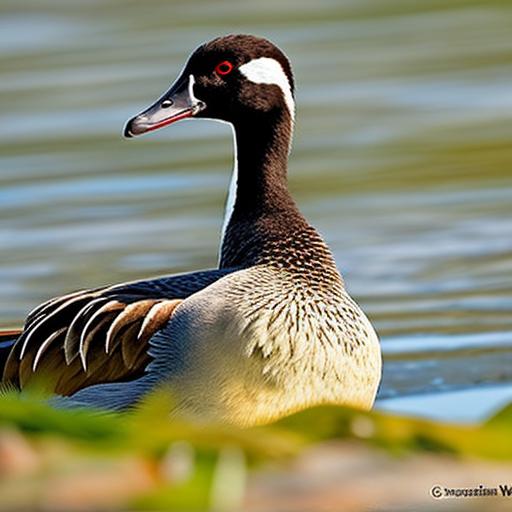Canadian geese are a common sight on beaches across Canada, but their presence can often cause problems for both beachgoers and the geese themselves. The geese can leave behind droppings that can be unsightly and unsanitary, and their aggressive behavior can sometimes lead to conflicts with humans. Finding humane solutions to manage geese populations is important to ensure the well-being of both the geese and the people who enjoy the beaches.
Key Takeaways
- Canadian geese are attracted to open spaces near water and grassy areas.
- Physical barriers such as fences and netting can be effective in deterring geese.
- Visual deterrents like decoys and reflective tape can scare off geese.
- Sound devices like propane cannons and speakers can be used to keep geese away.
- Natural repellents like grape extract and predator urine can discourage geese from settling.
Understanding the Behavior of Canadian Geese
Canadian geese are known for their distinctive honking call and their V-shaped flight formations. They are migratory birds that breed in Canada during the summer months and then fly south for the winter. Geese are attracted to beaches because they provide open spaces, access to water, and a source of food. They are herbivores and feed on grasses, grains, and aquatic plants.
Implementing Physical Barriers to Deter Geese
One method of deterring geese from beaches is by implementing physical barriers. These barriers can include fences, netting, or even floating barriers in the water. The goal is to create a physical barrier that prevents the geese from accessing the beach and its surrounding areas.
There are pros and cons to using physical barriers. On one hand, they can be effective at keeping geese away and preventing them from causing damage or conflicts with humans. However, they can also be expensive to install and maintain, and they may not be aesthetically pleasing.
Utilizing Visual Deterrents to Scare Off Geese
Visual deterrents can also be used to scare off geese from beaches. These deterrents can include things like scarecrows, reflective tape, or even decoy predators like plastic owls or coyotes. The idea is to create a visual stimulus that makes the geese feel threatened or uncomfortable.
Visual deterrents have their own set of pros and cons. They can be relatively inexpensive and easy to install, and they can be effective at scaring off geese. However, they may not be as effective in the long term, as geese can become habituated to them over time.
Implementing Sound Devices to Keep Geese Away
Sound devices can also be used to keep geese away from beaches. These devices emit loud noises or distress calls that can scare off the geese. Examples of sound devices include propane cannons, ultrasonic devices, or even recordings of predator calls.
Using sound devices has its own set of pros and cons. They can be effective at deterring geese and preventing them from settling on beaches. However, they can also be disruptive to beachgoers and may not be suitable for all beach environments.
Using Natural Repellents to Discourage Geese

Natural repellents can also be used to discourage geese from beaches. These repellents can include things like grape extract, garlic oil, or even predator urine. The idea is to create a scent or taste that is unpleasant to the geese and makes them want to avoid the area.
Using natural repellents has its own set of pros and cons. They can be environmentally friendly and safe for both humans and geese. However, they may not be as effective as other methods and may need to be reapplied regularly.
Implementing Habitat Modification to Make Beaches Less Appealing to Geese
Another method of managing geese populations on beaches is by implementing habitat modifications. This can include things like planting tall grasses or shrubs that make it difficult for geese to access the beach, or removing food sources like grass clippings or spilled food.
There are pros and cons to implementing habitat modifications. They can be effective at making beaches less appealing to geese and preventing them from settling. However, they may require ongoing maintenance and may not be suitable for all beach environments.
Establishing a Regular Maintenance Schedule to Prevent Geese from Settling
Regular maintenance is important to prevent geese from settling on beaches. This can include tasks like regularly cleaning up food scraps or trash, removing nests or eggs, and maintaining physical barriers or deterrents.
Regular maintenance is important because it helps to create an environment that is less appealing to geese and prevents them from establishing a permanent presence on the beach. It also helps to ensure the cleanliness and safety of the beach for both humans and wildlife.
Educating the Public on Proper Behavior Around Geese
Educating the public on proper behavior around geese is crucial to managing geese populations on beaches. This can include things like not feeding the geese, not approaching them too closely, and not disturbing their nests or eggs.
Proper behavior around geese is important because it helps to minimize conflicts between humans and geese and ensures the safety and well-being of both. It also helps to create a positive relationship between humans and wildlife.
Collaborating with Wildlife Experts to Manage Geese Populations
Collaborating with wildlife experts is important when it comes to managing geese populations on beaches. These experts can provide valuable insights and guidance on the best methods for managing geese populations in a humane and effective way.
Wildlife experts can help with things like conducting population surveys, implementing management strategies, and providing education and outreach to the public. Their expertise can help ensure that geese populations are managed in a way that is sustainable and beneficial for both humans and wildlife.
Developing a Comprehensive Geese Management Plan for Beaches
Developing a comprehensive geese management plan for beaches is essential to effectively manage geese populations. This plan should include a combination of methods, such as physical barriers, visual deterrents, sound devices, natural repellents, habitat modifications, regular maintenance, and public education.
A comprehensive geese management plan should also include regular monitoring and evaluation to assess the effectiveness of the methods being used and make any necessary adjustments. It should also include a long-term strategy for managing geese populations in a sustainable and humane way.
Managing geese populations on beaches is important to ensure the well-being of both the geese and the people who enjoy the beaches. There are a variety of methods that can be used to manage geese populations, including physical barriers, visual deterrents, sound devices, natural repellents, habitat modifications, regular maintenance, public education, and collaboration with wildlife experts. By implementing a comprehensive geese management plan that incorporates these methods, we can find humane solutions to manage geese populations and create a positive relationship between humans and wildlife.
If you’re looking for the best way to keep Canadian geese off of beaches, you might find this article on Poultry Wizard quite helpful. It provides valuable insights and strategies on how to effectively deter geese from invading beach areas. From understanding their behavior patterns to implementing non-harmful deterrents, this article offers practical solutions for maintaining a goose-free beach environment. Check it out here for more information.
FAQs
What are Canadian geese?
Canadian geese are a species of waterfowl that are native to North America. They are known for their distinctive black heads and necks, white cheeks, and brown bodies.
Why are Canadian geese a problem on beaches?
Canadian geese can be a problem on beaches because they can leave behind large amounts of droppings, which can be unsightly and unsanitary. They can also be aggressive towards people and other animals.
What is the best way to keep Canadian geese off of beaches?
There are several methods that can be used to keep Canadian geese off of beaches, including using decoys, using noise deterrents, and using physical barriers. The most effective method will depend on the specific situation.
What are decoys?
Decoys are objects that are designed to look like Canadian geese in order to scare them away. They can be made from a variety of materials, including plastic and wood.
What are noise deterrents?
Noise deterrents are devices that emit loud noises in order to scare Canadian geese away. They can be powered by electricity or batteries and can be set to go off at regular intervals.
What are physical barriers?
Physical barriers are structures that are designed to prevent Canadian geese from accessing a beach. They can be made from a variety of materials, including netting and fencing.
Meet Walter, the feathered-friend fanatic of Florida! Nestled in the sunshine state, Walter struts through life with his feathered companions, clucking his way to happiness. With a coop that’s fancier than a five-star hotel, he’s the Don Juan of the chicken world. When he’s not teaching his hens to do the cha-cha, you’ll find him in a heated debate with his prized rooster, Sir Clucks-a-Lot. Walter’s poultry passion is no yolk; he’s the sunny-side-up guy you never knew you needed in your flock of friends!







